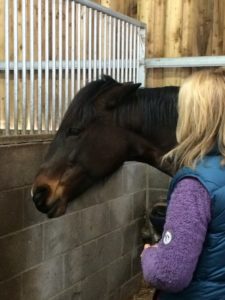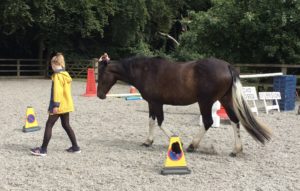It’s been a hot, muggy day and my little girl has finally fallen asleep after the excitement of returning to school. I take a moment, stepping into the garden to stop and breathe, listening to the pitter-patter of the rain on the sunshade above. That wonderfully distinct aroma of fresh rainfall on the hot ground envelopes me. With it comes a sense of relief and appreciation.
With the summer holidays now over, like so many of us, I have been experiencing the ongoing challenges of finding the right balance between family, work, my own needs, and time with ‘Boots’… Just as I was beginning to feel quite overwhelmed, I had a timely reminder of the important things in life, as my little girl came down with a nasty dose of Scarlet Fever! It was time to let some of the juggling balls drop. I had to re-prioritise and accept that my blog, facebook, various house chores, and some of my goals with ‘Boots’ just had to wait…

“Good horsemanship is understanding the horse physically, mentally, emotionally and spiritually.”
After hearing what ‘Boots’ had to say during our first session I knew my work was cut out for me. As an experienced horse trainer and behaviour consultant I was aware there were many potential reasons for her behaviour. As such I would need to go through a steady process of elimination to get to the root of her problems. First however, I knew I needed to focus on building trust and a mutually beneficial relationship, to create a foundation from which to build on.
For me it was clear from the start that physical pain or discomfort may be driving her behaviour. When I considered her previous history of injuries, accidents and incidents, it was possible any of these could have resulted in lasting physical (and emotional) effects. Pain would certainly explain her defensive reactions, history of rearing, refusal to load into a trailer, and aversion to clipping. At the same time her attachment history and number of different handlers would also lead to feelings of insecurity and hyper vigilance, adversely affecting her ability to build relationships and learn. Plus her current lack of turnout and interaction with other horses would be negatively impacting on her mentally, physically, and emotionally.
Whatever the potential causes, be it Pain, Behavioural or Both, I was faced with the reality of how it is for Boots now, and the need to prioritise what I was going to do to help her most. How I needed to find ways to meet her behavioural needs and build trust and confidence in our relationship. So that we could go on to safely explore, and hopefully eliminate, any potential physical problems that were contributing to her behaviour.
When exploring ‘behavioural problems’ most good horse trainers understand the impact of physical pain and advocate ruling this out, first and foremost. Although I totally agree with this, when there is no obvious problem or lameness it is not always easy to find the source, or to get a clear diagnosis – especially with a horse that will not tolerate touch or travelling to the vet!! In fact in my experience, the stresses involved in numerous tests can activate the horse’s innate ability to mask any physical problems or weaknesses and put real strain on their relationships. Potentially increasing the chances of things being exacerbated, missed, or misinterpreted.
‘ALL behaviour IS communication’ and ‘Behaviour is driven by emotions’

So starting with curiosity, I needed to objectively observe her body language within a variety of environments and situations: What was she actually doing? Where, when, and with whom does the behaviour occur? What happens before, during, and after the behaviour? What happens if I change what I am doing or asking?… All questions that would help me to identify any triggers and find ways to create more positive interactions.
I also needed to get creative. To become playful, thinking outside the box to try different ways to build trust and confidence in our relationship, focusing on modeling and engaging the CARE, SEEKING & PLAY emotional systems to build a strong bond and secure attachment. I needed to give her unconditional Love, setting aside my ego, judgments’ and limiting beliefs, to tune in and listen to her needs and wants. Always accepting her perspective, empathising with her, and adapting what I was doing to avoid the FEAR and RAGE systems. Whilst ensuring she had equine companions close by to avoid triggering the PANIC/LOSS emotional system.
Hence I started working with her within the environment where she appeared most comfortable and relaxed. With her trusted friend and companion alongside. (See previous video). Mindful of her aversion to touch I reminded myself to ask for her permission to do so, giving her the freedom to express herself and the choice to interact, or not, as far as possible. A challenge to my ego perhaps, but vital if I wanted to build a true trust based relationship.
I explored ways to create benefit in our interactions, introducing a number of different objects and obstacles to encourage curiosity and exploration. Whilst adding in some treats to find, to activate the SEEKING system, I was building her confidence to being on her own with me. All the while working to ensure her behavioural needs of turnout and companionship where met as far as possible. This led to our first breakthrough session where Boots started to experience the benefits of touch and engaging the CARE emotional system. See photos below…
To demonstrate here is a short clip of one of our early liberty sessions where Boots is empowered to communicate her concerns. She is given the time and space to consider and process what we are doing, and although I use a mild aversive signal to regain her attention, there is no escalation of pressure, or expectations on what she ‘should’ be doing. As you can see she is just beginning to look to me for guidance and reassurance, seeking security when she becomes spooked, or unsure of her environment. Link to video
These days I can see that this foundation work is all paying off and it is rare to see her ‘grumpy’ face, even when faced with new and potentially scary situations. In fact this summer I had the pleasure of witnessing ‘Boots’ happily meet, gently interact with, and chose to follow my kids around at Liberty, bringing a sense of joy to my heart.
Next time I will be sharing more about the challenges of our journey, the ups and downs, and the steps I took to uncover the source of her concerns..
In the meantime, it’s been a while since my last post, so I’d love to hear if you are reading and finding these blogs useful. If so, please ‘like’, share, or comment below and if you have any questions, then please don’t hesitate to ask.
Till next time, enjoy the moment, with a little #TLC
With best wishes
Debbie
The 7 Core Emotional Systems
Jaak Panksepp, an Affective Neuroscientist has spent a lifetime studying animal emotions and identified 7 Core Emotional Systems, shared by all mammals. Each system has different levels of arousal. Our brains and nervous systems are social organs and so it is through these emotional systems that we are able to tune in with each other but more on that next time…
• RAGE – Frustration, irritation, restraint
• FEAR – Pain, threat, foreboding
• GRIEF – Separation distress, panic, social loss
• CARE – Maternal, nurturing, social bonding
• PLAY – Playfulness, joy.
• SEEKING – Explorative urge, curiosity, anticipation, desire
• LUST – Copulation in adults
The systems in italic all activate the sympathetic nervous system creating discordant energy and the stress response. – Fight, Flight, Freeze, Fawn. Whilst those in bold activate the parasympathetic nervous system creating coherent energy and the calming response – Rest & Digest. For more information on these emotional systems and the way horses feel, please check out this wonderful series of videos by Rachel Bedingfield.


Debs
Brilliant blog Debbie, I just adore reading about this journey with Boots. The photographs of her allowing herself to be touched are just fantastic, a curious face rather than a grumpy one, well done!!
admin
Thanks Debbie, I’m glad you are enjoying the blog. Taking photo’s is certainly a challenge but she’s now come a long way since these were taken and loves a really good scratch!! 🙂
K
Thank you for your blog about Boots. I find it very inspiring especially as
I am also trying to connect with a horse who’s had a troubled past. It certainly is an emotional rollercoaster, it’s easy to feel despondent when things aren’t going too well but I have more hope after reading of your experiences, I feel more determined to keep going and i’ll definitely be reading your next installment with much interest. Thank you.
admin
Hi Karen, thank you for your lovely comment and I am so pleased you have found it helpful. It certainly can be challenging yet hugely rewarding to work with horses that have been through any trauma but the PACE model gives us a great framework to support their healing – just remember to apply it to yourself in those challenging or despondent moments too and you will get there! With best wishes, Debbie 🙂
Mark Francis
Lovely well written piece, I look forward to the next.
Boots is a beauty
admin
Thank you Mark, she certainly is isn’t she! I believe you can tick the box below these comments to be notified when the next blog is posted. In the meantime, please do check out the previous 3 posts in this series… With thanks & best wishes, Debbie.
Wendy Brooks
I just read about you I’m out local Test Valley magazine and was inspired to look at your website. What a heartwarming story. We have three beautiful horses opposite us who are looked after with great care and stabled in the winter. When my cat went missing two summers ago she was sighted in their field and for several evenings I sat there quietly calling to her. One of the horses seemed concerned and used to come over and gently nudge me on the shoulder as if reassuring me. They surely are intuitive and intelligent animals. Good luck on your continued journey with boots and PS my cat came back!
admin
Dear Wendy, thank you for reaching out with your lovely story, and I am so pleased to hear you were reunited with your cat! 🙂